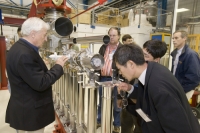 |
 |
|||||||||||||
|
|||||||||||||
|
|||||||||||||
|
Last week, more than 100 scientists from around the world met at Fermilab to discuss recipes for baking, rinsing and polishing. Not the kind used for baking a cake, instead attendees at the TESLA Technology Collaboration meeting shared information about developing the optimal recipe for pushing superconducting radiofrequency, or SCRF, technology forward.
As the chosen technology for the International Linear Collider, the SCRF cavity is a hot (or cold) topic for hundreds of scientists who are contributing to R&D for the proposed electron-positron accelerator. On a larger scale, the mission of the TTC is to advance SCRF technology and related accelerator studies across the broad spectrum of scientific applications, providing a forum for the world's experts to share ideas, developments and tests. “The ILC is a big component right now, but there are many other applications for this technology,” said Cornell University's Maury Tigner, chair of the TTC. The meeting at Fermilab marked the fourth TTC workshop, originally established in 2004 in response to the decision to use SCRF technology for the ILC. At a time when new advancements in SCRF technology are occurring weekly, the meeting allowed experts to ask questions and seek out advice for producing the optimal superconducting cavity. “In recent weeks, we achieved an accelerating gradient of 59 megavolts per metre, which exceeds the initial expected capabilities for this technology,” Tigner said. “This is wonderful, but there is a real concern about the variations in performance from one cavity to the next.” Superconducting cavity recipes aren't simple. The tiniest piece of dust inside a cavity can impact how efficiently it can accelerate particles, and getting the cavities sparkling clean is a complicated process. Laboratories and universities throughout the world have each developed their own cavity recipes, making it difficult to determine which is the best process. In order to overcome this hurdle, members of the TTC are developing one specific recipe for all labs to use. “We need more testing to get more data before we will know if this recipe works,” said John Mammosser of Jefferson Laboratory, during the TTC meeting. “We need to make sure to stick with this one recipe and not change it until we understand its performance. It is really difficult to do this because you always want to try new things, but we won't learn anything if we keep changing the recipe.” Mammosser hopes to have enough data to evaluate this recipe by the next TTC meeting, In between discussions on simplifying the process for treating superconducting cavities, meeting attendees toured Fermilab's ILC test facilities. Attendees visited the lab's brand new horizontal test stand and a functioning cryomodule assembly building, just a few of the highlights of Fermilab facilities that will be used by collaborators around the world. -- Elizabeth Clements For more information on the meeting talks, visit the TTC meeting web site. |
|||||||||||||
| © International Linear Collider |
